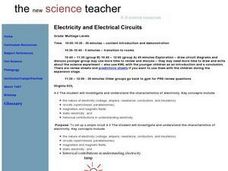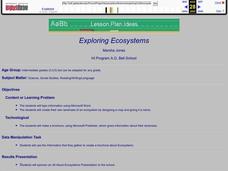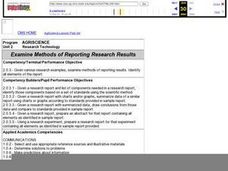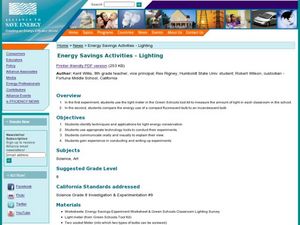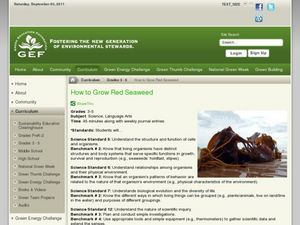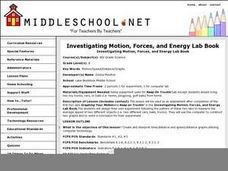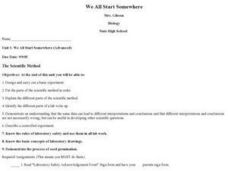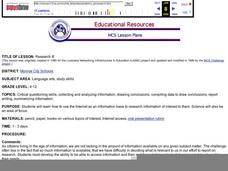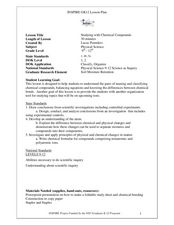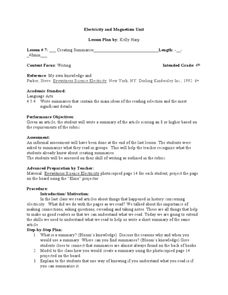Curated OER
Electricity and Electrical Circuits
Students are introduced to electricity and electrical circuits. In groups, they draw circuit diagrams, complete a KWL chart and discover the difference between open, closed and series circuits. They define new vocabulary and make...
Curated OER
A Tale of Two Wetlands
Students observe 2 separate wetlands (following downloadable worksheets) and record 10 similarities and 10 differences between them. Then they present their recommendations to the class who roleplay the government's wetland conservation...
Curated OER
Exploring Ecosystems
Students examine the characteristics of an ecosystem. They create their own landmass of an ecosystem and creating a map of the area. They develop a brochure sharing information about their new landmass.
Curated OER
Examine Methods of Reporting Research Results
Learners analyze a research report and the list of components needed in a research report and then identify those components based on a set of standards using the scientific method. They collect data which can be used for a graphical...
Curated OER
Why did the can crush?
Students watch a demonstration to ascertain why a soda can crushed. They make observations and hypothesize about why a soda can crushed and relate the difference in pressure to its affect on objects around us (soda can). Explanation is...
Curated OER
Energy Saving activities Lighting
Eighth graders study how light emits energy. In this energy savings lesson plan, 8th graders conduct two experiments to find ways to save energy. In one experiment students measure the light in each classroom and make recommendations for...
Curated OER
How To Grow Red Seaweed
Students explore ocean biology by participating in a plant growing activity. In this seaweed lesson, students identify the importance and uses of seaweed in the ocean and examine different seaweed samples. Students utilize an aquarium,...
Mary Pope Osborne, Classroom Adventures Program
Mummies in the Morning Egyptian pyramids, hieroglyphics
Visit the Magic Treehouse and take your class on a trip through time with a reading of the children's book Mummies in the Morning. Using the story to spark an investigation into Egyptian culture, this literature unit engages...
Curated OER
How Do You Know There is Air in a Bag?
Fourth graders explore air as a material substance. Through experimentation and discussion, they explore how air can be classified as a material substance. Students write three examples proving that air is a material substance in their...
Curated OER
Investigating Motion, Forces, and Energy Lab Book
Eighth graders create their own experiements using toy trucks, cars or balls to measure the time it takes two of them to travel 5 meters, as well as at each 1 meter interval. They make use computers to make a time/distance graph and...
Curated OER
We All Start Somewhere
Students demonstrate an understanding that the same data can lead to different interpretations and conclusions and that different interpretations and conclusions are not necessarily wrong, but can be useful in developing other scientific...
Curated OER
Where Do Green Plants Get Energy?
Fourth graders realize that plants need light, water, and carbon dioxide to carry out photosynthesis. They participate in groups of 4 to plant (with materials provided) a test group of beans to compare to the control group, write a...
Curated OER
Scientific Inquiry: Periodic Motion
Young scholars construct their own pendulum. In this physics lesson, students design an experiment to find the factors affecting its period. They formulate a conclusion based on experimental data.
Curated OER
Spring Collecting and Identifying Bumble Bees
Young scholars collect bumble bees in the field, record data, identify and release specimens, answer conclusion questions, and send data in to researcher leaders. They make research based conclusions based upon the evidence.
Curated OER
Hare vs. the Tortoise
Seventh graders identify and create questions and hypotheses, dependent and independent variables and form a conclusion that can be answered and tested through scientific experimental investigation. For this relationship lesson, 7th...
Curated OER
Studying with Chemical Compounds
Students create a foldable to help them remember topics on chemical compounds. In this physical science instructional activity, students differentiate ionic and covalent compounds. Given certain compounds, they identify whether it's...
Curated OER
Spring Collecting and Identifying Bumble Bees
Students collect bumble bees in the field, record data, pin and label specimens, answer conclusion questions, and send specimens to research leaders for verification. They improve their ability to work in research teams. Students...
Curated OER
Silent Spring
Students read background information about Rachel Carson found on the listed website links. They analyze and answer questions about her work and how it is linked to science then they research pesticide usage and alternative methods.
Curated OER
Creating Summaries
Fourth graders generate written summaries from non-fiction articles. In this writing lesson plan, 4th graders determine what must be included in writing a good summary and then work in small groups to construct summaries after...
Curated OER
Weather Journal
Sixth graders write in a journal using weather observations as the focus, they develop writing techniques in addition to scientific observation skills.
Curated OER
Scientific Approach to Forest Management
Learners use wireless laptop computers to collect, store, communicate, and organize data from the 1999 Jasper Fire area. They collect data in the field and compare it to student-collected data from prior years to develop conclusions...
Curated OER
What Do You Know About Saturn?
Young scholars discuss what they know about Saturn. They create drawings to show what the planet looks like and identifies its characteristics. They write a paragraph about the planet as well.
Curated OER
Is It Alive?
Eighth graders define the boundaries of living organisms. They determine what makes something a living organism and identify factors that constitute "living." Pupils write a conclusion about the evidence they found that yeast is alive...
